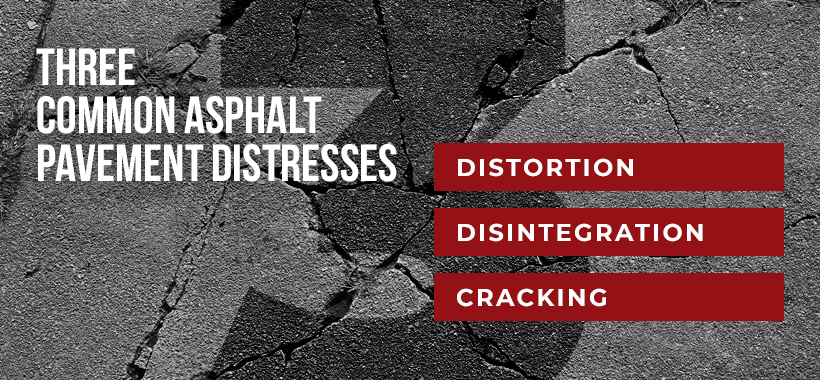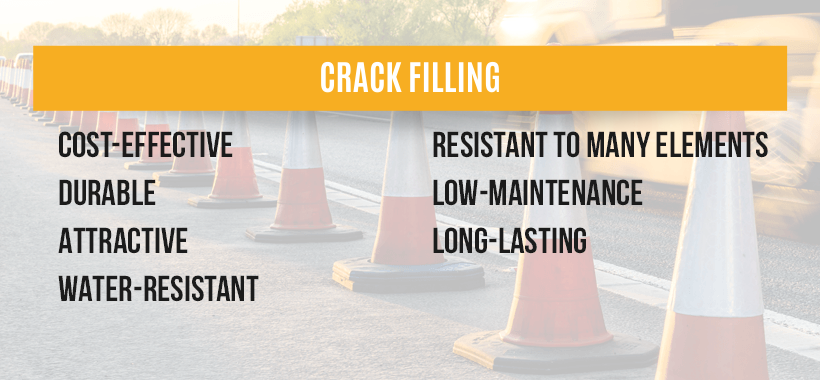Differences Between Crack Filling and Crack Sealing
Table of Contents
Asphalt is a reliable, cost-effective surface that can last for decades if it's installed and maintained properly. However, just like any other material, asphalt will show signs of distress as it ages. Thankfully, asphalt crack filling and crack sealing can help you repair and preserve your asphalt parking lot or roadway. In order to treat asphalt damage, it's important to be aware of how the surface was impacted by distress, and which repair method is the correct treatment.
Contact Us for Commercial Crack Filling
1. Three Types of Asphalt Damage

Unfortunately, asphalt will always be susceptible to damage and weaken over time. Day after day, pavement is exposed to the sun's ultraviolet rays, which bake the essential strength and flexibility properties out of asphalt. Exposure to UV rays can leave asphalt brittle and full of hairline cracks that make the surface vulnerable to water invasion from rain. During the winter months, ice and cold temperatures can cause asphalt to expand and contract, resulting in more damage. Traffic pressure and motor oil from vehicles can also accelerate pavement surface deterioration. Surface distress, defined as any signs of poor performance or impending failure, can manifest in three ways:
- Distortion: Any change in the surface of the pavement is considered distortion. An unstable or weak subgrade surface, movement of the subgrade soil or base compaction from traffic can cause depressions, shoving, corrugations, channeling or upheaval.
- Disintegration: This can be caused by a loss of bond between the asphalt binder and the aggregate particles because of inadequate compaction or dislodging by traffic.
- Cracking: Fractures in the asphalt can appear for a number of reasons including contraction, slippage, temperature changes, moisture and fatigue.
While all forms of surface distress provide cause for concern, the cracking of an asphalt surface can especially be a reason to worry.
Call Us for Commercial Crack Filling
2. How Serious are Asphalt Cracks?
Cracked asphalt should be taken seriously by a property owner or manager, and should be addressed as soon as possible. Crack filling is the first line of defense in protecting asphalt, and it is the best way for a property owner to save money in the long run. Left untreated, asphalt cracks can lead to more significant problems, like potholes. Once the subbase of your asphalt fails, you will be left with no choice but to spend thousands, and sometimes tens of thousands, of dollars to repair and re-pave your parking lot. Crack filling, on the other hand, is a comparatively cheap and easy option to protect your asphalt from further damage.
Keep in mind that the state of your parking lot can also have an influence on your building's curb appeal, which is an important factor in sales prices and observable property attributes. A parking lot displaying signs of neglect will negatively impact visitors to your establishment. By increasing curb appeal, a well-maintained parking lot will also lower your liability.
Whether you're the owner or manager of the establishment, it's your responsibility to ensure the asphalt is properly maintained so pedestrians and vehicles stay free from potential harm. It is also in your best financial interest to have your pavement on a regularly-scheduled crack filling maintenance program.
3. Eight Types of Asphalt Cracks

Not all cracks are the same. Though they may seem like random lines sprawled throughout an asphalt surface, the specific distress the surface experiences cause unique cracks to form. The first step in determining the best way to treat your asphalt cracks is to properly identify the type of cracks.
Alligator Cracks
Alligator cracking, also known as fatigue cracking or "spiderwebbed" cracking, occurs when the asphalt surface fails from fatigue and repeated heavy loads of traffic. Cracks will only appear in heavy traffic loading areas. For instance, it may occur across heavily used parking spaces but not in areas of the lot that only pedestrians use. It may also occur in areas that tractor trailers drive over repeatedly. These interconnected cracks begin as parallel lines that rise from the asphalt base. They then connect as increased traffic places more pressure on the surface.
The severity of the distress will be displayed through the alligator cracks. Parallel cracks that minimally connect are considered low level. Networks of cracks that display patterns or are spalled are considered moderate-level. High-level asphalt distress is apparent when the networks of cracks have created well-defined, spalled edges that may move when traffic rolls over them. Either way, alligator cracks point to subbase failure, meaning these areas will have to be removed and re-paved.
Block Cracks
Block cracking also includes interconnected cracks. However, instead of cutting the asphalt into small pieces, block cracks often divide large areas of pavement into rectangular pieces longer than one foot. Whereas alligator cracking occurs in areas of heavy vehicle traffic, block cracks can happen anywhere along the pavement. Shrinkage and temperature changes cause distress on hardened asphalt and may eventually create a block crack.
Longitudinal Cracks
These type of cracks run parallel to the centerline of the pavement are considered longitudinal cracks. Unlike alligator cracks, which can appear on the wheel path, longitudinal cracks are not found in those places. They develop from within the pavement itself, not from the surface or bottom. This type of cracking is especially important for asphalt in permafrost regions. The air void, binder content and temperature of PG grade can influence the possibility of longitudinal cracks. Crack filling and crack sealing is a great solution for longitudinal cracks.
Edge Cracks
Longitudinal cracks that emerge within two feet or less of the outer edge of the pavement are categorized as edge cracks. Due to a lack of support at the edge, edge cracks appear near the unpaved side of the road.
Transverse Cracks
Opposite of longitudinal cracks, transverse cracks run perpendicular to the centerline of the pavement. The distresses that create these fractures are not load-related. Rather, the reflection from existing cracks or asphalt layer shrinkage may cause transverse cracking.
Reflection Cracks
Reflection cracking won't occur in a single pavement surface. Parking lots and roads that use asphalt overlays may see these type of cracks appear when the pavement beneath the overlay begins to move. The cracks displayed mirror the patterns on the base structure. Heavy traffic loads, temperature fluctuations and movements of the earth can cause these cracks.
Slippage Cracks
When the bond between the surface layer of the asphalt and the course beneath are inadequate, slippage cracking may occur. Foreign elements like dust, dirt and oil can reduce this bond, allowing crescent-shaped cracks to manifest due to distress from the turning or braking of traffic.
Shrinkage Cracks
Sometimes, a lack of traffic can actually accelerate cracking. Shrinkage cracks are typically caused by volume changes in the asphalt mix. The cracks connect to form block patterns that have distinct angles and corners. Decreases in traffic volume over the pavement can increase asphalt shrinkage.
Contact Us for Commercial Crack Filling
4. How to Repair Asphalt Cracks
While we understand that property owners and managers may want to attempt to repair cracked asphalt themselves to save money, we strongly suggest you first consult a professional pavement maintenance company. We can identify the specific damage, its cause and the most appropriate repair solution. Call us today for a free crack filling quote for your parking lot or roadway at 1-800-334-4929.
Daniel B. Krieg uses a PennDOT-approved rubberized crack filler that is highly efficient and provides a number of benefits:
- Cost-Effective: Crack filling decreases the cost to maintain asphalt in the long-run. Crack filling also offers a low average investment that is ultimately 20 to 30 times less expensive than replacing neglected asphalt.
- Durable: Crack filling extends pavement life by as much as two decades.
- Attractive: Crack filling enhances the safety and appearance of your parking lot, ensuring your customers and employees remain happy and unharmed.
- Water-Resistant: Crack filling prevents further asphalt damage by limiting water from penetrating the asphalt.
At Daniel B. Krieg, we can apply crack filler to nearly any asphalt surface including roads and highways, parking lots and airport runways.

Our company uses advanced equipment to first clean each crack so that the filler material can bond to a clean reservoir. Next, we fill each crack with our rubberized material via a pressurized wand.
We recommend filling the cracks when the pavement is completely dry, ideally between March and November.
5. Maintenance Tips
Although you will never be able to completely avoid asphalt deterioration, you can proactively care for and extend the lifespan of your lot. Performing proper maintenance of your parking surface can help you identify problems and seek out solutions before they turn into costly damages.
We suggest you create a maintenance plan and stick to it. Remaining aware of the condition of your asphalt is an effective way to protect your investment and minimize expenses.
Generally, we recommend filling your asphalt cracks annually to maintain pavement surface integrity. We also recommend sealcoating your pavement every three to five years. Visit the "sealcoating" section of our website for more information on sealcoating.
Comparing the expenses, routine crack repair with Daniel B. Krieg can cost as little as 50 cents per lineal foot, a fraction of cracked asphalt repair costs that can stretch as high as six dollars per square foot. The combined maintenance of regular asphalt crack filling and sealcoating can enable your asphalt parking lot to last for as long as three decades without the need for a replacement.
Choose Daniel B. Krieg, Inc. for Expert Commercial Sealcoating

Daniel B. Krieg, Inc. is ready to help you keep your pavement protected. Named a top sealcoating contractor eight years in a row by Pavement Maintenance Magazine, we have a team of highly trained professionals ready to provide commercial asphalt sealcoating, crack filling and tack and prime coat services to those in counties throughout Central Pennsylvania, Delaware, Maryland, New Jersey, West Virginia and Virginia. Since 1933, we have remained a leader in pavement maintenance service.
Don't let a simple crack cost you your investment. Protect and restore the condition of your asphalt by trusting the industry leader in pavement maintenance: Daniel B. Krieg, Inc. Call or contact us today for a free quote.
Contact Daniel B. Krieg For A Quote
Please contact Daniel B. Krieg, Inc. by filling out the form below, or by calling us at one of our locations.
Harrisburg Office
-
 6730 Allentown Blvd.
6730 Allentown Blvd.
Harrisburg, PA 17112 Map It >> -
 Mon - Thurs: 8:00 am - 4:00 pm
Fri : Closed
Sat : Closed
Sun : Closed
Mon - Thurs: 8:00 am - 4:00 pm
Fri : Closed
Sat : Closed
Sun : Closed -
 800.334.4929
800.334.4929
717.564.2400
Fax: 717-558-2036 -
 Contact Us
Contact Us
-
 Leave a Review
Leave a Review
York Office
-
 3331 Gulton Road
3331 Gulton Road
York, PA 17404 Map It >> -
 Mon - Thurs: 7:00 am - 3:30 pm
Fri : 8:30 am - 3:30 pm
Sat : Closed
Sun: Closed
Mon - Thurs: 7:00 am - 3:30 pm
Fri : 8:30 am - 3:30 pm
Sat : Closed
Sun: Closed -
 717.792.0284
717.792.0284
Fax: 717.792.0640 -
 Contact Us
Contact Us
-
 Leave a Review
Leave a Review

![]()
LEAVE US A REVIEW
 Back To Top
Back To Top

